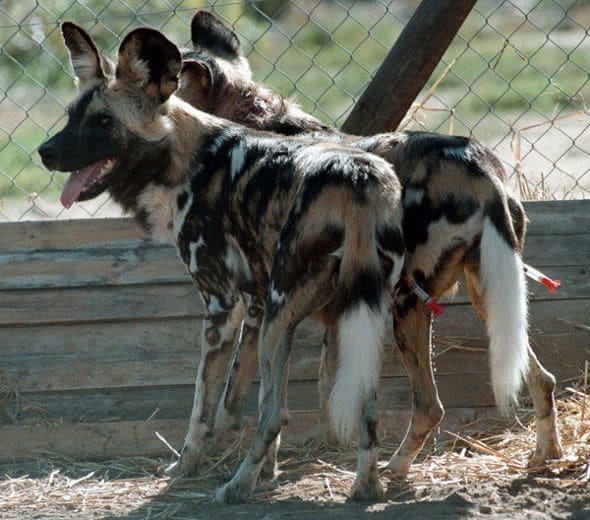A two-year-old boy has been mauled to death by a pack of ravenous African wild dogs when he fell off a railing his mother put him on to view the animals at the Pittsburgh Zoo and Aquarium.
Desperate rescue attempts by zookeepers and armed police officers could not deter the 11 aggressive beasts as they savagely attacked the child, from Pleasant Hills, Pittsburgh.
Zookeepers fired darts and a police officer opened fire, killing one of the African painted dogs, an endangered animal, but rescuers still could not reach the boy in time.
The boy fell over a railing and off a mesh barrier where the dogs were on display about 11.45am on Sunday.
His horrified mother, 34, who had taken him to zoo, watched as the dogs attacked the boy.
Police don’t know whether the boy died from the 11-foot fall or from the attack.
Zookeepers quickly drove off seven of the dogs, which are slightly smaller than Labrador retrievers, but the others could not be stopped. The dogs are particularly strong and have no fear. They are known to gang up on lions in the wild and bring down buffaloes and Wildebeests.
Employees pounded on the railings of their pen and shouted at the animals in an effort to deter them. A flurry of darts also did not drive them back.
When Pittsburgh police intervened, one especially aggressive dog refused to back down and stop attacking the boy. It was shot dead by an officer.
Zoo officials said there is a mesh barrier beyond the railing, but Lt Kraus said it was designed to catch small objects such as cameras, and not humans.
Investigators have not determined the exact cause of death, he said.
The Allegheny County Medical Examiner’s Office said the boy’s name would not be released until later today.
The boy and his mother were visiting the park with relatives – an adult and another child – at the time of the attack.
Police said the boy’s father arrived soon after the accident and both parents are currently being medicated to deal with the shock.
The zoo was closed, and it was not clear when it would be reopen, authorities said.
‘The screams just kept coming and coming: “Someone help. Someone has to do something,”’ witness Angela Cinti, 20, who was visiting the zoo with her boyfriend said.
‘We were on our way to the polar bear exhibit when we heard the most horrible piercing screams,’ Ms Ciniti recalled. ‘Someone was begging for help, asking someone to do something.’
Guests recounted being hurried into the nearest building for safety, waiting for a half an hour according to Ms Cinit.
‘We were locked down in the building and told to stay inside,’ Ms Cinit said. ‘We thought it was a problem with one of the animals that got loose. Then we were told it was an incident with the wild dogs and that a child had been hurt.’
In May, 200 patrons were rushed inside buildings and the zoo was put on lock-down when nine of the dogs sneaked out of the exhibit and found its way into a secondary holding pen.
Alone, the dogs, which weigh up to 80 pounds, can be formidable, but in packs they are vicious…capable of hunting and killing prey many times their size.
The dogs, which are endangered, are among the most deadly predators of the Serengeti Plain. Their hunts end in a kill 80 per cent of the time. Lions have a success rate of just 30 per cent.
But in all honesty, these are wild animals and were doing what comes natural to them in the wild.
Lt. Kevin Kraus of the Pittsburgh police described the accident as ‘horrific’, but keeping animals in zoos is, ‘horrific’. They are good for keeping certain species alive and have good breeding programmes, but other than that…why are there zoos in the 21st century?
OK…so there’s zoos, and we can’t help that right now. But why, oh why, and how, was this boy allowed to fall into a section of a part of the zoo. The zoo must take the blame for this. The African Wild Dogs should not be made a scape-goat in this.
by John Jackson


